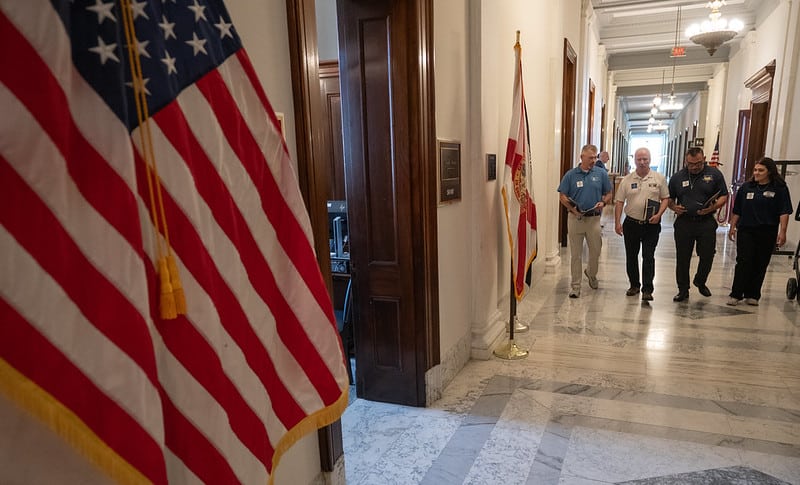
Strained to the Breaking Point
Among the handful of neurologically impaired patients in Judy Danella’s care one day last week were three so ill that they struggled just to swallow.
She fed each of them in turn, delivering spoonful after spoonful of pureed food, patiently nourishing them toward better health even as she herself was stretched thinner by the minute in a facility that’s chronically shorthanded.
Danella and her union co-workers at Robert Wood Johnson University Hospital in New Brunswick, N.J., wrestle every day with the understaffing crisis straining America’s health care system to the breaking point.
Health care employers across the country long refused to hire adequate numbers of nurses, certified nursing assistants, dietary workers and other essential staff, preferring to push skeleton crews to the bone and put profits over patients.
But now, the same health care workers who battled COVID-19 are fighting for the safe staffing levels needed to protect their communities on a daily basis and prevent the already-fragile care system from collapsing in the next pandemic.
U.S. Sen. Sherrod Brown of Ohio and Rep. Jan Schakowsky of Illinois just introduced legislation in Congress to establish mandatory minimum staffing levels for nurses at hospitals nationwide. But in the meantime, citing the ever-greater urgency, union workers continue advocating for similar measures on a state-by-state basis.
Danella and fellow members of the United Steelworkers (USW), for example, will rally with workers from other unions at the New Jersey statehouse May 11 to demand passage of bills establishing minimum staffing levels for registered nurses in hospitals, ambulatory surgery centers and state psychiatric facilities.
“You want to give the patient the best care you can,” explained Danella, a registered nurse and president of USW Local 4-200, which represents about 1,650 registered nurses at the Robert Wood Johnson facility, a Level 1 trauma center.
The legislation, already introduced in the state Senate and General Assembly, would require one registered nurse for every four patients in an emergency department, one for every two patients in intensive care, and one for every five patients in a medical/surgical unit, among other provisions.
The bills also would give the nurses a voice in designing and implementing staffing systems that model future needs, deploy “floaters” to cover gaps and provide further adjustments to better serve patients needing extra attention. That’s the kind of flexibility and forward thinking essential to providing proper care for all patients, especially on days when Danella needs up to 90 minutes just to feed three people.
“You prioritize your work,” said Danella, explaining how she handles the constant stream of text messages alerting her to more tasks assigned to her throughout her shift. “You just somehow get through the day, and you manage.”
Although Danella relies on her experience to handle whatever the hospital throws at her, industry-wide understaffing puts patients around the country at risk.
In Washington, for example, another state where union members are fighting for safe staffing levels, 48 percent of health care workers in a recent survey cited incidents of patient harm or deaths due to understaffing.
And in Michigan, where union workers have spent years fighting for minimum staffing ratios, 42 percent of nurses recently reported knowing of patients who died because of short-staffing. In 2020, nurses at a Detroit hospital filed a lawsuit claiming they were illegally fired for pointing out that short-staffing contributed to dozens of unnecessary deaths in the emergency department.
The Safe Patient Care Act, legislation that would have required hospitals to meet minimum staffing levels for registered nurses, died in Michigan’s Republican-controlled legislature last session. Now, Jackie Anklam, president of USW Local 9899, hopes the Democratic majorities that took control of both chambers in January will enact minimum ratios for nurses and other groups of health care workers as well.
“It should be for all,” stressed Anklam, whose local represents hundreds of workers at Ascension St. Mary’s Hospital in Saginaw, noting union members in every department contribute to a collective life-saving mission.
Anklam said current shortages force pharmacy technicians into brutally long days. Short-staffing also traps certified nursing assistants with high caseloads. And instead of hiring more environmental services workers, she said, the hospital increases workloads.
The staffing crisis affects not only hospitals but facilities across the continuum of care.
The USW and other unions want the Centers for Medicare & Medicaid Services (CMS) to establish minimum staffing levels at nursing homes and other long-term care facilities, funded largely with federal dollars, that serve growing numbers of aging Americans.
The ratios would not only save lives but decrease the amount of time residents wait for therapy as well as help dressing, bathing and using the restroom.
In addition, Chris Sova, a registered nurse and president of USW Local 15301, said minimum staffing would help to address the stress that workers experience as they race to answer one call bell after another.
“In the background, it’s a constant dinging,” said Sova, whose members at Bay County Medical Care Facility in Essexville, Mich., take pride—despite their own staffing challenges—in answering call bells at high speed.
“It’s like the water dripping in the middle of the night,” Sova said. “It’s just one of the many things wearing on you.”
While workers receive extra pay because of short staffing, he added, “they just want more help.”
Danella knows that the hospital industry will continue to oppose staffing minimums and cut corners to fatten their bottom lines. But she said union workers refuse to back down because continuing shortages will only exacerbate staff turnover and put even more lives at risk.
“It’s just a domino effect,” she said.
By clicking Sign Up you're confirming that you agree with our Terms and Conditions.
Related Blogs
Ready to make a difference?
Are you and your coworkers ready to negotiate together for bigger paychecks, stronger benefits and better lives?

